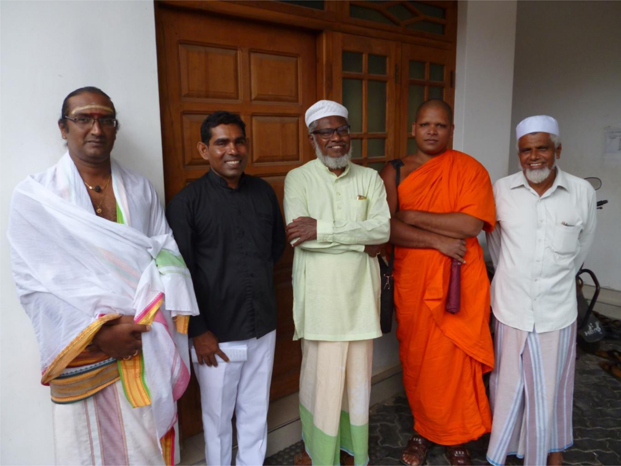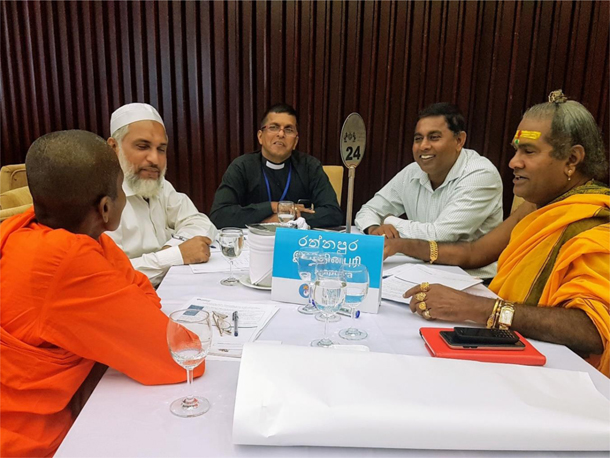
Figure 1. District Interfaith Leaders
CASE STUDY
James Samuel Pendera, Cletus Praveen Gomezb, Ranasinghe Arachchige Tuder Mahesh Pererac, John Anthony Williamsd, Ravindran Roshane
a Programmes and Advocacy Officer – Asia, The Leprosy Mission England and Wales, United Kingdom
b Alliance Development Trust, Sri Lanka
c Alliance Development Trust, Sri Lanka
d Alliance Development Trust, Sri Lanka
e Alliance Development Trust, Sri Lanka
Sri Lanka is a leprosy endemic country with one of the highest incidences of the disease globally. Low levels of leprosy awareness were identified as one of the reasons for high prevalence. In order to address this low awareness, inter-faith communities were mobilized by trained church leaders to work together to increase leprosy awareness, reduce stigma, and support people affected by leprosy, building strong relationships across inter-religious divides in the process. The efforts were highly successful with over 30,000 people involved in leprosy awareness events. This indicates that faith communities can be an important partner for development agencies and governments; churches can make an impact in improving health outcomes, even where the members are a persecuted minority, as well as contribute to inter-communal peacebuilding efforts.
Key words: leprosy, health, church, inter-faith, Sri Lanka
There is an increasing number of new leprosy cases being detected in Sri Lanka despite the greater economic prosperity in the region. This is unusual, as higher leprosy prevalence is usually associated with lower-income developing countries. In 2017, 1,877 new cases1 with 195 child cases were identified in Sri Lanka.2 These statistics indicate high rates of transmission and, although the long-running conflict in the country may have contributed to this, one of the leading causes is low levels of awareness,3 and misconceptions and prejudices still exist even among public healthcare workers,4 which have contributed to insufficient leprosy detection.
Therefore, Alliance Development Trust (ADT), an arm of the National Evangelical Alliance of Sri Lanka (NCEASL), with support from The Leprosy Mission England and Wales (TLMEW) started to look at how it could raise awareness of leprosy, reduce stigma, and contribute to increased detection. The project’s major resource was the island-wide network of churches with which it was associated and its previous experience of working on a project to reduce HIV/AIDS stigma. ADT offered support to those affected by leprosy through churches and a partnership with district interfaith committees.
When ADT began working with interfaith leaders, it mobilized district interfaith committees under the Inter Religious Peace Foundation. The Foundation had originally been set up in 1993 by religious clerics trying to bring about peace between the different religious and ethnic communities that were polarized along religious and ethnic lines during the conflict in Sri Lanka.5 Many of these committees had been largely inactive for years, and some had not previously existed in some districts, so they needed to be formed for the first time. They were brought together with the objective of leaving their differences aside to fight a common enemy—leprosy.
A core team was formed involving one church pastor representing each district of the country, thereby making it a 25-member core team. Members of the teams were nominated by the district pastors’ fellowship teams. They were given leprosy training by the Government Anti-Leprosy Campaign (ALC) who recognized them as “trained community leaders for community awareness programmes on leprosy.” Each core team member was then tasked with the responsibility of mobilizing church leaders in their respective districts. The core team selected churches and pastors known to them and who were part of their respective district pastor’s fellowship teams. The core team met every quarter to plan and report progress of their respective district interventions. The district church teams were firstly trained by their district public health inspectors about leprosy and then raised awareness within their respective churches by conducting leprosy awareness Sunday services. Church pastors were also taken through training on integral mission so that they understood the need to love their neighbor while they loved God.
Next, each district team was linked up with a district interfaith team. The interfaith leaders were all members of the Inter Religious Peace Foundation with which ADT had an agreement. Each interfaith committee consisted of a representative of each major faith community in the locality, including Buddhists, Hindus, Muslims, and Christians (Evangelical, Anglican, and Catholic) (Figure 1). The representatives were mostly clerics but also included elders from their congregations. Other interested community and religious leaders sometimes attended the training meetings. After training, individual representatives organized outreach events within their religious community or jointly with other interfaith committee members. The core team pastors then became district facilitators for the interfaith committees, organizing meetings supported by ADT that together coordinated leprosy awareness activities in each district. These district committees worked alongside the Government ALC’s district Public Health Inspector-Leprosy who attended meetings as a trainer and resource person and utilized the committee members to spread awareness through their networks, including places of worship, schools, women’s groups, and youth groups.

Figure 1. District Interfaith Leaders
As a result of this intervention, 25 pastors were trained as core team members, who in turn trained 785 church leaders at the district level and reached 20,640 church members through 349 leprosy awareness Sunday services in the first year (Table 1). Through 78 interfaith awareness events in 2017 and 2018, 9,630 individuals heard about leprosy (Table 2).
This led to the diagnosis of 58 new cases of leprosy. Twenty people affected by leprosy received asset transfers to enable them to improve their livelihoods with new income generating activities and better relations between different communities. It is suspected that there may have been further new cases diagnosed due to an increased number of leprosy cases self-presenting after awareness activities, but this could not be verified as once a suspected person visits the government hospital for diagnosis, there is no record maintained to know whether or not an affected person suspected leprosy as a result of an interfaith awareness program.
In addition, it is notable that the intervention appears to have had a positive impact on the Government ALC because in leprosy detection, it is important to trace the close contacts (family members, neighbors, close friends) of leprosy index cases that have been newly diagnosed as there is a higher probability of them contracting leprosy. So, it was encouraging that the preliminary data suggested that contact tracing improved in districts that ran successful interfaith awareness programs; the contact tracing percentage of the districts with inter-faith activities was high and averaged at 82% compared with districts that had not implemented them, which averaged at 77%. Furthermore, the districts with interfaith activities had a higher percentage (7.4%) of new cases detected via contacts compared with districts without the interfaith activities (3.5%). The results were statistically significant (p < 0.05). 6
The approach of working through pastors and churches proved effective in raising awareness of leprosy, but this was mostly limited to the Christian community, and as leprosy is a health condition which comes within the remit of the Government ALC, churches were not able to work on it independently outside their congregations.
However, when the Director of the Government ALC trained the core team on leprosy, the core team members were recognised as trained community leaders for community awareness programs on leprosy. The Director recommended that Public Health Inspectors-Leprosy (PHI-L), who coordinate leprosy control in each district, utilize their services. This opened up the opportunity for close partnership with the ALC, but religious sensitivities also meant that Christians were viewed with suspicion, and the ALC were wary of only using pastors to raise awareness. By expanding the program to all religions, the programme became acceptable to the authorities. In addition, Evangelical Christians are a small minority, and it also made sense to include other faith leaders who could expand the reach and impact of the awareness on leprosy into communities the church pastors would struggle to access. It was also an opportunity for the trained church leaders at district and local levels to show that they did not just care about “saving people from sins” but also saving them from their present sufferings and showing the positive contribution they could bring to wider society.
This initiative is also of wider benefit as it contributed to peace-building and inter-religious harmony. Inter-religious and inter-ethnic mistrust or misunderstanding exists as a result of the recent conflict as well as rising nationalistic sentiment. In some parts of Sri Lanka, mosques and churches have been burnt down, and religious minorities report persecution.7 However, members of the inter-faith committees working in this program improved community relationships and improved relations with counterparts of other religious backgrounds, and they believed that these relationships could function to defuse communal tensions in the future.
What began as a church-based initiative has now become a successful interfaith initiative that is “owned” as part of the Sri Lankan Government’s intervention to reduce leprosy prevalence across the country.
There are several lessons to be drawn from this project. Firstly, it demonstrates that projects involving churches in their communities are possible even in countries where Christians are a small minority and suffer persecution. It also shows that other faith communities are willing to work alongside Christians to make a difference in their communities (Figure 2). The project also arguably contributed just as much towards peacebuilding and increased understanding in a fragile context as to health outcomes.

Figure 2. Interfaith collaboration to address leprosy
Secondly, by working in a professional and strategic manner, the church (in this case through its development wing ADT) can become a valued strategic partner of the government. The government, in turn, recognizes the importance of involving faith communities in achieving improved community health outcomes.
Thirdly, it led to a change in outlook among participating churches. They went beyond preaching to their communities to understanding the value of being “salt and light” in their communities. They then reaped the benefits of improved relations with their neighbors. The churches, as a result, were more highly regarded, as the Gospel is being demonstrated as well as talked about. It is also important that churches learn how to engage with other faiths in positive ways and become more open to those of other faiths without compromising their message. Engagement around a neutral topic, such as reducing leprosy, of which everyone could agree, was a helpful way to start.